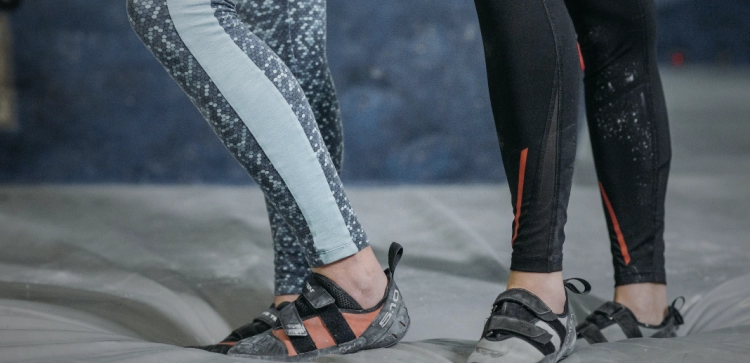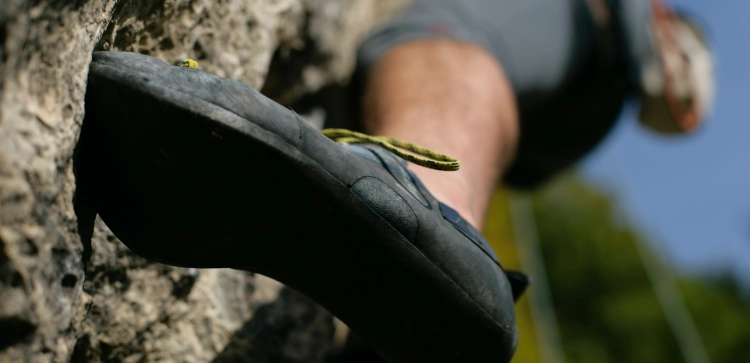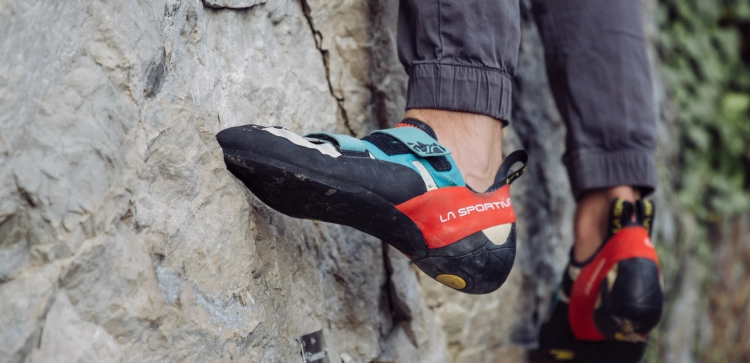Climbing Shoes 101: How To Pick The Right Pair For You

Climbing shoes are an essential part of climbing, and choosing the right pair of climbing shoes that are not only the right size but also the right shape and fit, is crucial. Whether climbing is just your hobby, or it is a sport you are dedicating yourself to, learning how to pick climbing shoes that are right for you is a very important skill.
- The Importance Of Choosing The Right Climbing Shoes
- 6 Essential Tips For Selecting The Best Climbing Shoes
- Understanding The Purpose Of Climbing Shoes: What To Consider When Choosing A Pair
- Matching Your Climbing Shoes To Your Climbing Style
- Is It Worth It To Spend More On Climbing Shoes? Weighing The Pros And Cons
- Does The Rubber Matter When Choosing Climbing Shoes?
- Consider Your Climbing Level When Selecting Climbing Shoes
- Leather Vs Synthetic Climbing Shoes: What To Know
- Don't Just Follow The Crowd: Find The Best Climbing Shoes For You
- Wrapping Up: Final Points To Consider When Choosing Climbing Shoes
The Importance of Choosing the Right Climbing Shoes
The right climbing shoes for you will provide better support and grip, while poorly fitting or unsuitable shoes can hinder performance and cause discomfort. Consider factors such as size, fit, aggression level, rubber type, and shoe materials when selecting climbing shoes. By picking the right shoes for your feet and climbing style, you can improve your climbing performance and overall enjoyment.
6 Essential Tips for Selecting the Best Climbing Shoes
Before we get into the more detailed sections of this article, here are a few quick and short tips to keep in mind while looking for climbing shoes:
- The shoes your friends have or recommend may not be the right ones for you.
Just because others think they are great, and they may in fact be great, doesn’t mean they are right for you, both in terms of size and in terms of shape and fit. Try them, don’t just trust that they will be good for you. - Some shoes stretch, and some shoes don’t stretch.
This is a crucial piece of knowledge to keep in mind when buying climbing shoes. You wouldn’t want to spend so much money on small climbing shoes, thinking they will stretch 2 sizes, when in fact they probably will never stretch more than half a size. - Don't let the price decide for you, expensive shoes are not always better shoes.
Just because some shoes cost more, does not mean they are better than cheaper shoes. It especially does not mean that they will be a better fit for you than the cheaper shoes. Try on the expensive shoes and the cheaper ones, compare them, and make your decision based on the shoes and how they fit your feet, not based on the price.
- Understand what you are buying them for.
If you are buying the shoes for long multi-pitch routes, you probably don’t want to be in shoes that were sized down very aggressively, otherwise, your toes will be in throbbing pain. Keep in mind the type of climbing you will be doing in these shoes. - Know that there are different shapes of climbing shoes for different shapes of feet.
If you have wide feet, you may want to buy climbing shoes for wider feet, these shoes tend to have a wider profile, and a wider toe box, which means less cramping of the toes and less pain. The same is true for climbers with narrow feet, there are shoes specifically for narrow feet. Understand the type of feet you have, and try to match the shoes to your feet, and not the other way around. - Ask for help in the store when choosing climbing shoes.
The people who are there to sell you the shoes should hopefully know quite a bit about them and should be able to help you find the right pair for your feet. - Sellers don’t always understand what they are selling.
In somewhat of an opposition to the previous point, not all sellers understand what they are selling. The store you are buying your shoes from may have hired people who are not climbers themselves, who have no climbing experience or experience with climbing shoes, and who have no real knowledge of climbing shoes. So while asking them for help is a good idea, it is also equally important to identify when they just can’t help so that you don’t end up buying something that is not right for you.
Understanding the Purpose of Climbing Shoes: What to Consider When Choosing a Pair
Climbing shoes are meant to be snug and tight. The dead space inside the shoes should be minimal so that your feet do not move within the shoes while you are climbing in them.
The reason for this is to provide better support while climbing, better grip, better accuracy, and to give you the ability to output more force and pressure from your feet.
If your shoes are too loose, too big, or just not snug enough, these benefits may be greatly reduced, and thus your climbing could be negatively affected. At the least, you may just not be fully benefitting from your climbing shoes.
An example of when this is significant is when you have a difficult heel hook that requires you to pull or hold your weight on a small hold. If you have dead space in the area of your heel, your shoe may be on the climbing hold, but your foot may be over it, which will result in your heel slipping off. A tight and snug enough climbing shoe that is the right fit will not have that dead space around the heel. This means that your shoe and your foot will actually be on the hold, allowing you to perform the heel hook successfully.
Matching Your Climbing Shoes to Your Climbing Style
Matching your climbing shoes to your climbing style is important when choosing a pair of climbing shoes.
While you can technically climb in any type of climbing shoes for any style of climbing, it is recommended to get the right shoes for your climbing style.
Keeping your intended climbing style in mind while picking climbing shoes can help ensure that you are buying the right shoes for you and that you will get the most benefits from your shoes.
Choosing the Right Shoes for Different Types of Climbing
There are different styles of climbing, such as bouldering, sport climbing, and trad climbing. Climbing shoes are designed differently and specifically for these different kinds of climbing styles. Choosing shoes that are specifically designed for the type of climbing you will be doing in them can greatly impact your performance.
For example, if you prefer bouldering, you may want to pick a pair of shoes with a more aggressive shape and a downturned toe for better precision and support on steep routes.
On the other hand, if you prefer trad climbing, you may want to pick a pair of shoes with a more flat and comfortable fit for long multi-pitch routes.
Aggressive vs Flat
When choosing climbing shoes, you should consider the level of aggression or curvature of the shoe.
Shoes with a more aggressive shape are better for sport climbing or bouldering, while flat, comfortable shoes are better for trad climbing or multi-pitch routes.
Pick a pair of shoes that matches your climbing style and the type of routes you'll be climbing to improve your performance and comfort.
Is It Worth It to Spend More on Climbing Shoes? Weighing the Pros and Cons
Climbing shoes are not the cheapest climbing gear, they can be quite expensive. Because of this, it's important to weigh the pros and cons of spending more on climbing shoes.
Higher-priced shoes may offer better materials, better overall build quality, a more precise fit, and improved performance, but they may not always be necessary for all climbers.
Consider your needs and budget when deciding whether to spend more on climbing shoes or not. Factors such as your climbing experience and frequency can also determine the need for more expensive shoes.
In the end, it is up to you to understand what your needs are, and your budget, and to weigh your options. Here is a quick pros and cons list to help guide you, but you should also add to the list your own personal considerations:
Pros:
- Higher quality materials: Higher-priced climbing shoes may be made from more durable and comfortable materials, which can improve the overall fit and performance of the shoe.
- Better construction: Higher-priced climbing shoes may also be made with more attention to detail and better construction techniques, which can improve the overall quality and lifespan of the shoe.
- Improved performance: Higher-priced climbing shoes may offer more advanced features, such as a more aggressive shape or specialized rubber, which can improve your climbing performance and help you send harder routes.
Cons:
- Higher cost: An obvious one. If you have a budget, you should really consider if the more expensive shoes fit into that budget.
- May not be necessary: If you are just starting out with climbing or only climb occasionally, you may not need the advanced features and performance that higher-priced climbing shoes offer. In these cases, it may be more cost-effective to choose a more budget-friendly option.
Does the Rubber Matter When Choosing Climbing Shoes?
The type of rubber used in climbing shoes is important, as the type of rubber can have a big impact on your performance and the lifespan of the shoes.
Some climbing shoes use stickier rubber for better grip on small climbing holds, and some use harder rubber for more support on edges and on longer routes. Softer rubber is known to wear out faster than harder rubber, which means the lifespan of the shoes may be shorter than harder rubber.
Having some knowledge of the different kinds of rubbers used in climbing shoes can help you make a better decision when buying shoes. If you are on a tight budget and you buy climbing shoes with soft rubber, and you climb frequently, you may end up with holes in the rubber quite fast. At that point, you could either continue climbing in them until they are too damaged to climb in, and then buy new ones, or, you may decide to send them to get a resole. Both options will cost additional money, so keeping this in mind can help you choose the right shoe for your needs.
Consider Your Climbing Level When Selecting Climbing Shoes
When selecting climbing shoes, it is important to consider your climbing level and choose a pair of shoes that is suitable for your abilities and needs. Different climbing shoes are designed for different climbing levels, from beginner to advanced, and choosing the right shoe for your level can greatly impact your climbing performance and enjoyment of the sport.
For example, if you are just starting out with climbing, you may want to choose a pair of shoes with a more flat and comfortable fit that is easier to wear for longer periods of time. As you progress and become more advanced, you may want to choose a pair of shoes with a more aggressive shape and specialized features that can help you tackle more challenging routes.
Leather vs Synthetic Climbing Shoes: What to Know
There is quite a big difference between leather climbing shoes and synthetic climbing shoes, which is mainly due to the sizing and fit of the shoes.
Leather climbing shoes stretch quite a lot. They can stretch anywhere from half a size to 2 whole sizes, and sometimes even more. Synthetic climbing shoes, on the other hand, usually only stretch up to about half a size, and in many cases, they do not stretch at all.
In addition to size, leather shoes also tend to mold themselves to the climber's feet, providing a much better and more comfortable fit. This, along with the stretching of the shoes, means that within a few months of climbing in them, they may end up fitting very differently from when you bought them. This is why climbers who buy leather shoes tend to size down so aggressively. Because they know the shoes will stretch and mold to the shape of their feet.
Synthetic shoes, though, do not change almost at all. They stretch only about half a size and do not mold themselves to your feet. This means that synthetic shoes will most likely still fit the same way as they did when you bought them, even after 6 months of climbing in them.
Understanding the difference between leather shoes and synthetic shoes is very important when buying climbing shoes. If you buy synthetic shoes and size down, expecting them to stretch 2 sizes and mold to your feet, you will be very disappointed later on.
Don't Just Follow the Crowd: Find the Best Climbing Shoes for You
When choosing climbing shoes, it’s important to not make a decision based on what people consider “the best shoes”.
The right climbing shoes depend on the climber that will be wearing them. What is great for someone else, will not necessarily be great for you.
Consider your climbing style when buying shoes. How will you be climbing in them? What type of climbing will you be doing? How often do you climb?
Try on different shoes from different brands and in different sizes until you find the right size and fit for you. Not all climbing shoes are made the same, and they do not all fit the same. Find the shoes that fit the shape of your feet the best.
It doesn’t matter if the shoes that fit you best are not the most popular shoes. What matters is that they fit you and that they meet your needs. You will be the one climbing in them, not others.
Wrapping Up: Final Points to Consider When Choosing Climbing Shoes
In the end, what matters most is that you find climbing shoes that meet your needs, and that fit you the best.
It does not matter if they are cheap, expensive, popular, or unpopular. What matters is that they are right for you.
Use the above points as a guide to choosing the right climbing shoes for you, add to it, and change it as needed. Everyone has their own needs, their budget, and their uniquely shaped feet. Not all climbing shoes will be a great fit for you, but, having some knowledge about climbing shoes, your needs, and your feet can help you find and choose the best shoes for you.








